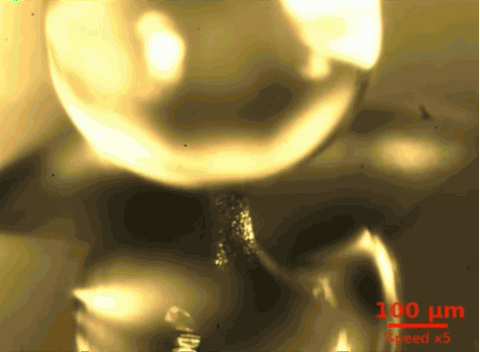Though origami is a craft that is believed to have originated as early as 905 CE, its practice has remained consistent in many ways over the subsequent centuries. The size and scope of origami endeavors have certainly grown, but the art still involves the folding and shaping of flat paper into 3D objects. Today, however, the Journal of Applied Physics published a report on a project that looks like a cross between 4D-printing (yup, self-assembling objects) and the paper-folding craft—in other worlds, extremely futuristic object folding.Scientists at the University of Twente in the Netherlands have created flat objects that morph into shapes that open and close like a blossoming flower after being subject to a drop of water. The material is made from silicon nitride wafers with small hinges carved into them. As depicted in the GIFs above, the flat surfaces evolve into cubes, pyramids, and other geometric forms at a microscopic scale when hit with a splash of liquid. We'd like to see this science applied to the chemistry-made nano flowers we covered in a documentary last week. Water makes flowers bloom, after all. In the project description, graduate student Antoine Legrain writes, "In the Origami project, we fabricate three-dimensional micro- and nanostructures by means of capillary forces…Capillarity is a particularly effective mechanism since it becomes dominant at small scales." The smaller the size, the better this process works. So the team dropped a very miniscule amount of water onto the structures, and when the water molecules started sticking to each other, the silicon pulled the 2D surfaces together into a folded design, just like origami.Each structure is about the size of a grain of sand, and the researchers think this innovation could be used in biomedical applications—be it for surgery, or even medicine that needs to expand within the body. This could be especially fruitful, since the structures could fold and unfold several dozen times without falling apart.Though this isn't origami in a traditional sense, we imagine some clever artists implementing the scientist's creation for some amazing micro-art. Just pair this material with nano-sculptor Vik Muniz and pretty soon we could have a sandbox full of grain-sized cranes.
In the project description, graduate student Antoine Legrain writes, "In the Origami project, we fabricate three-dimensional micro- and nanostructures by means of capillary forces…Capillarity is a particularly effective mechanism since it becomes dominant at small scales." The smaller the size, the better this process works. So the team dropped a very miniscule amount of water onto the structures, and when the water molecules started sticking to each other, the silicon pulled the 2D surfaces together into a folded design, just like origami.Each structure is about the size of a grain of sand, and the researchers think this innovation could be used in biomedical applications—be it for surgery, or even medicine that needs to expand within the body. This could be especially fruitful, since the structures could fold and unfold several dozen times without falling apart.Though this isn't origami in a traditional sense, we imagine some clever artists implementing the scientist's creation for some amazing micro-art. Just pair this material with nano-sculptor Vik Muniz and pretty soon we could have a sandbox full of grain-sized cranes. See the University of Twente's project page for more information.h/t TxchnologistRelated: [Exclusive Video] Creating Sand Castles With A Single Grain Of SandMeet The Artist Behind "Blacker-Than-Black", The Darkest Color Ever[Video] Crystal Nano Flowers And The Future Of Architectural Chemistry
See the University of Twente's project page for more information.h/t TxchnologistRelated: [Exclusive Video] Creating Sand Castles With A Single Grain Of SandMeet The Artist Behind "Blacker-Than-Black", The Darkest Color Ever[Video] Crystal Nano Flowers And The Future Of Architectural Chemistry
Advertisement

Advertisement

